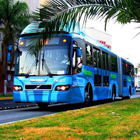
The objective of the BRT (Bus Rapid Transit) Macrobus in Guadalajara, Mexico is to establish an efficient, safe, rapid, convenient, comfortable and effective modern mass transit system based on a BRT system. The Metropolitan area of the city of Guadalajara has a population of around 3.7 million inhabitants. The situation before the project is around 1.6 million vehicles plying the city of Guadalajara of which more than 1 million private cars, 86,000 motorcycles, 12,000 taxis and around 4,600 public transit buses. The city has also two Light Rail Transit (LRT) lines totaling 24km of tracks. Public transport buses are owned and managed by 17 different private and public enterprises.
The PDD includes all phases of Macrobus with a total of 8 exclusive BRT bus lanes plus their feeder lines. The first line entered operations in March 2009. From 2012 onwards, around 1 line per year enters into operations totaling 185 km of trunk routes by mid 2017. The geographical boundary of the project is the metropolitan area of the city of Guadalajara. Gases included are CO2, CH4 and N2O.
Project emissions are based on the actual fuel consumption of buses forming part of the project. Leakage emissions are caused by changes of congestion and speed resulting potentially in a rebound and a speed effect plus potential change of load factors of remaining buses and taxis in the city. Emission reductions are the result of reduced GHG (Greenhouse Gases) emissions per passenger trip comparing the baseline with the project situation. The BRT Macrobus reduces GHG emissions by improving the resource efficiency of transporting passengers in the urban area of Guadalajara i.e. emissions per passenger trip are reduced compared to the situation without project. This is realized through following changes:
- Improved efficiency: new and larger buses are used which have an improved fuel efficiency per passenger transported compared with those used in absence of the project6. On trunk routes the project uses articulated buses with a capacity of 160 passengers, which is around double the baseline bus capacity of 82 passengers7.
- Mode switching: The BRT system is more attractive to clients due to reduced transport times, increased safety and reliability and more attractive buses. It can thus attract private car, motorcycle and taxi users with higher emission rates to switch to public transport.
- The integration with feeder lines allows for efficient transport trips of customers combining fine density feeder lines with high capacity trunk routes.
- Load increase or change in occupancy: The BRT has a centrally managed organisation dispatching vehicles on trunk routes. The occupancy rate of vehicles can thus be increased due to organizational measures. The baseline public transit system is characterized through a large number of private companies competing for the same passengers resulting in an oversupply of buses and low occupation rates.
- Reduction of the existing fleet of buses through public transit re-organization. This is an integral part of the BRT project.